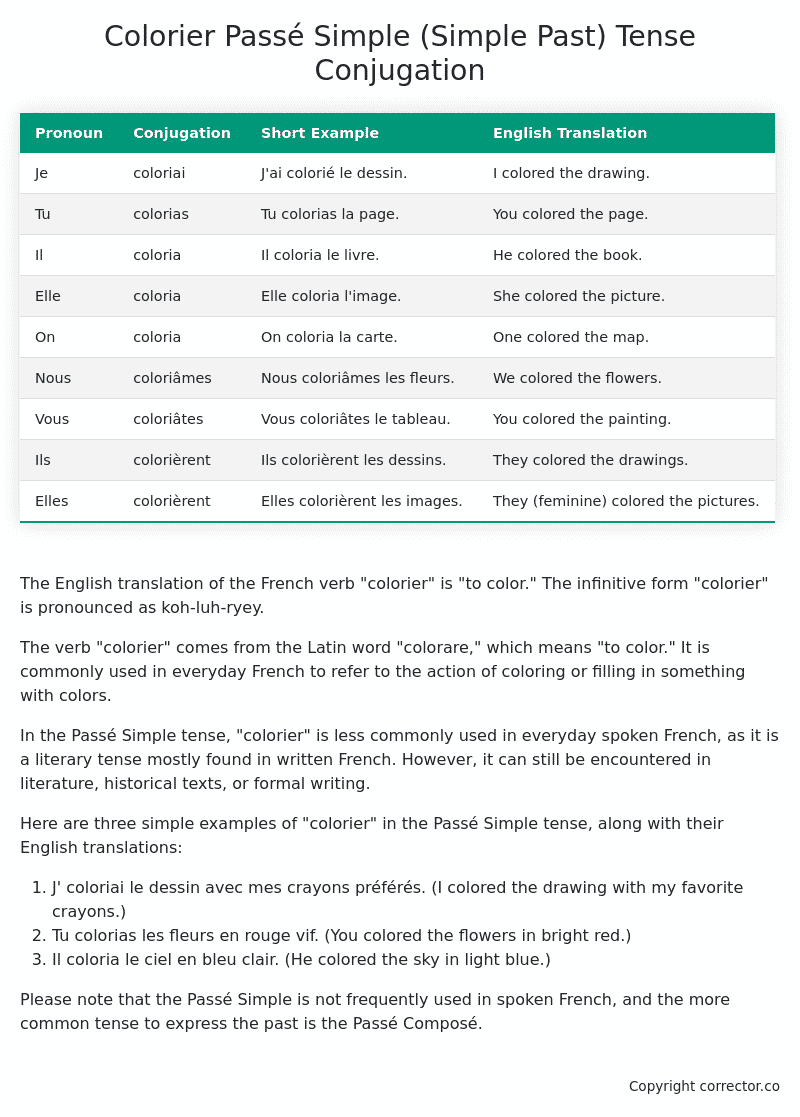Passé Simple (Simple Past) Tense Conjugation of the French Verb colorier
Introduction to the verb colorier
The English translation of the French verb “colorier” is “to color.” The infinitive form “colorier” is pronounced as koh-luh-ryey.
The verb “colorier” comes from the Latin word “colorare,” which means “to color.” It is commonly used in everyday French to refer to the action of coloring or filling in something with colors.
In the Passé Simple tense, “colorier” is less commonly used in everyday spoken French, as it is a literary tense mostly found in written French. However, it can still be encountered in literature, historical texts, or formal writing.
Here are three simple examples of “colorier” in the Passé Simple tense, along with their English translations:
- J’ coloriai le dessin avec mes crayons préférés. (I colored the drawing with my favorite crayons.)
- Tu colorias les fleurs en rouge vif. (You colored the flowers in bright red.)
- Il coloria le ciel en bleu clair. (He colored the sky in light blue.)
Please note that the Passé Simple is not frequently used in spoken French, and the more common tense to express the past is the Passé Composé.
Table of the Passé Simple (Simple Past) Tense Conjugation of colorier
| Pronoun | Conjugation | Short Example | English Translation |
|---|---|---|---|
| Je | coloriai | J’ai colorié le dessin. | I colored the drawing. |
| Tu | colorias | Tu colorias la page. | You colored the page. |
| Il | coloria | Il coloria le livre. | He colored the book. |
| Elle | coloria | Elle coloria l’image. | She colored the picture. |
| On | coloria | On coloria la carte. | One colored the map. |
| Nous | coloriâmes | Nous coloriâmes les fleurs. | We colored the flowers. |
| Vous | coloriâtes | Vous coloriâtes le tableau. | You colored the painting. |
| Ils | colorièrent | Ils colorièrent les dessins. | They colored the drawings. |
| Elles | colorièrent | Elles colorièrent les images. | They (feminine) colored the pictures. |
Other Conjugations for Colorier.
Le Present (Present Tense) Conjugation of the French Verb colorier
Imparfait (Imperfect) Tense Conjugation of the French Verb colorier
Passé Simple (Simple Past) Tense Conjugation of the French Verb colorier (You’re reading it right now!)
Passé Composé (Present Perfect) Tense Conjugation of the French Verb colorier
Futur Simple (Simple Future) Tense Conjugation of the French Verb colorier
Futur Proche (Near Future) Tense Conjugation of the French Verb colorier
Plus-que-parfait (Pluperfect) Tense Conjugation of the French Verb colorier
Passé Antérieur (Past Anterior) Tense Conjugation of the French Verb colorier
Futur Antérieur (Future Anterior) Tense Conjugation of the French Verb colorier
Subjonctif Présent (Subjunctive Present) Tense Conjugation of the French Verb colorier
Subjonctif Passé (Subjunctive Past) Tense Conjugation of the French Verb colorier
Subjonctif Imparfait (Subjunctive Imperfect) Tense Conjugation of the French Verb colorier
Subjonctif Plus-que-parfait (Subjunctive Pluperfect) Tense Conjugation of the French Verb colorier
Conditionnel Présent (Conditional Present) Tense Conjugation of the French Verb colorier
Conditionnel Passé (Conditional Past) Tense Conjugation of the French Verb colorier
Conditionnel Passé II (Conditional Past II) Tense Conjugation of the French Verb colorier
L’impératif Présent (Imperative Present) Tense Conjugation of the French Verb colorier
L’impératif Passé (Imperative Past) Tense Conjugation of the French Verb colorier
L’infinitif Présent (Infinitive Present) Tense Conjugation of the French Verb colorier
L’infinitif Passé (Infinitive Past) Tense Conjugation of the French Verb colorier
Le Participe Présent (Present Participle) Tense Conjugation of the French Verb colorier
Le Participe Passé (Past Participle) Tense Conjugation of the French Verb colorier
Struggling with French verbs or the language in general? Why not use our free French Grammar Checker – no registration required!
Get a FREE Download Study Sheet of this Conjugation 🔥
Simply right click the image below, click “save image” and get your free reference for the colorier Passé Simple tense conjugation!

Colorier – About the French Passé Simple (Simple Past) Tense
Formation
Usage
Narration
Historical Context
Interactions with other tenses
Passé Composé
Imparfait
Conditional and Subjunctive
Summary
I hope you enjoyed this article on the verb colorier. Still in a learning mood? Check out another TOTALLY random French verb conjugation!


